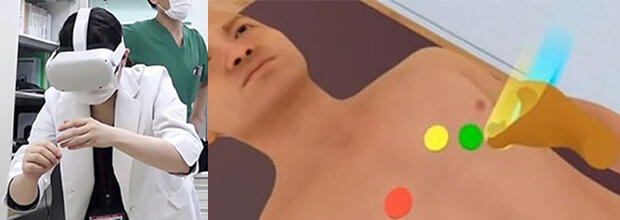On June 15, Kenya Kamimura, a specially appointed professor in the Department of General Medicine at the Niigata University School of Medicine, and his colleagues, in collaboration with Ima Create (headed by Akihiro Yamamoto and Hitoshi Kawasaki) announced that they have developed virtual reality (VR) training content for medical procedures. By wearing goggles, users can experience and train on seven different procedures in a VR space. The enhanced guide function allows medical students to study on their own.

(both courtesy of Niigata University School of Medicine)
The companies have developed NUP, a VR platform that shares body movements by converting them into 3D data and visualizing them. Through this platform, they have provided content on subjects such as exercise, welding and other machining techniques, measurement work and medical treatments.
Under the direction of the course, content has been developed to provide experience and training in seven medical procedures: abdominal visual inspection, abdominal auscultation, abdominal palpitation, electrocardiography, blood gas testing, thigh edema testing, and blood pressure measurement. A video capture of the content is available for reference and can be viewed on smartphones and PCs. (https://drive.google.com/file/d/1FUfUHvwytYcJ_VAmuSkDdPLOPW9rRZ3A/). The actual frame rate is said to be about three times higher, resulting in a smoother display.
The guide function can be turned on or off depending on the user, and when turned on, it allows for training to be done without any prior knowledge. Users can then move on to the next step, accurate technique. Users can expect to further improve proficiency through the use of a simulator that uses a model or other body simulator. In the future, the companies will engage in consultations and study how to provide this service and develop content for other procedures as well.
Medical testing and treatment require many techniques, and medical students and physicians learn these techniques through repeated training. Traditionally, medical students have prepared for clinical practice and clinical training by learning these procedures not only through books, videos, and other educational materials, but also through simulator training. More learning methods are expected to be developed through the widespread use of remote environments due to the spread of the COVID-19 pandemic.
"Moving forward, we would like to develop this system as a tool for learning about comprehensive medical care by expanding its content by promoting its use in multiple professions and making other improvements," explains Professor Kamimura. "We are also developing and adding VR with real images, with the aim of creating a system with a high degree of temporal and spatial flexibility. We expect to use it as a teaching tool for medical safety, such as for multidisciplinary collaborative orientations, hospital tours, and work line checks."
This article has been translated by JST with permission from The Science News Ltd.(https://sci-news.co.jp/). Unauthorized reproduction of the article and photographs is prohibited.




